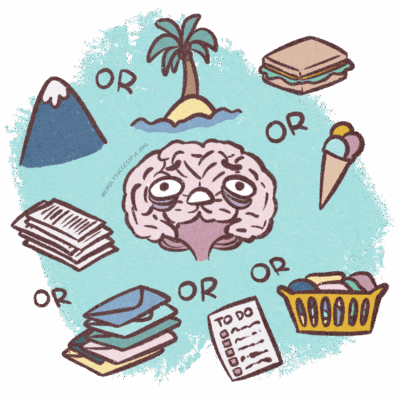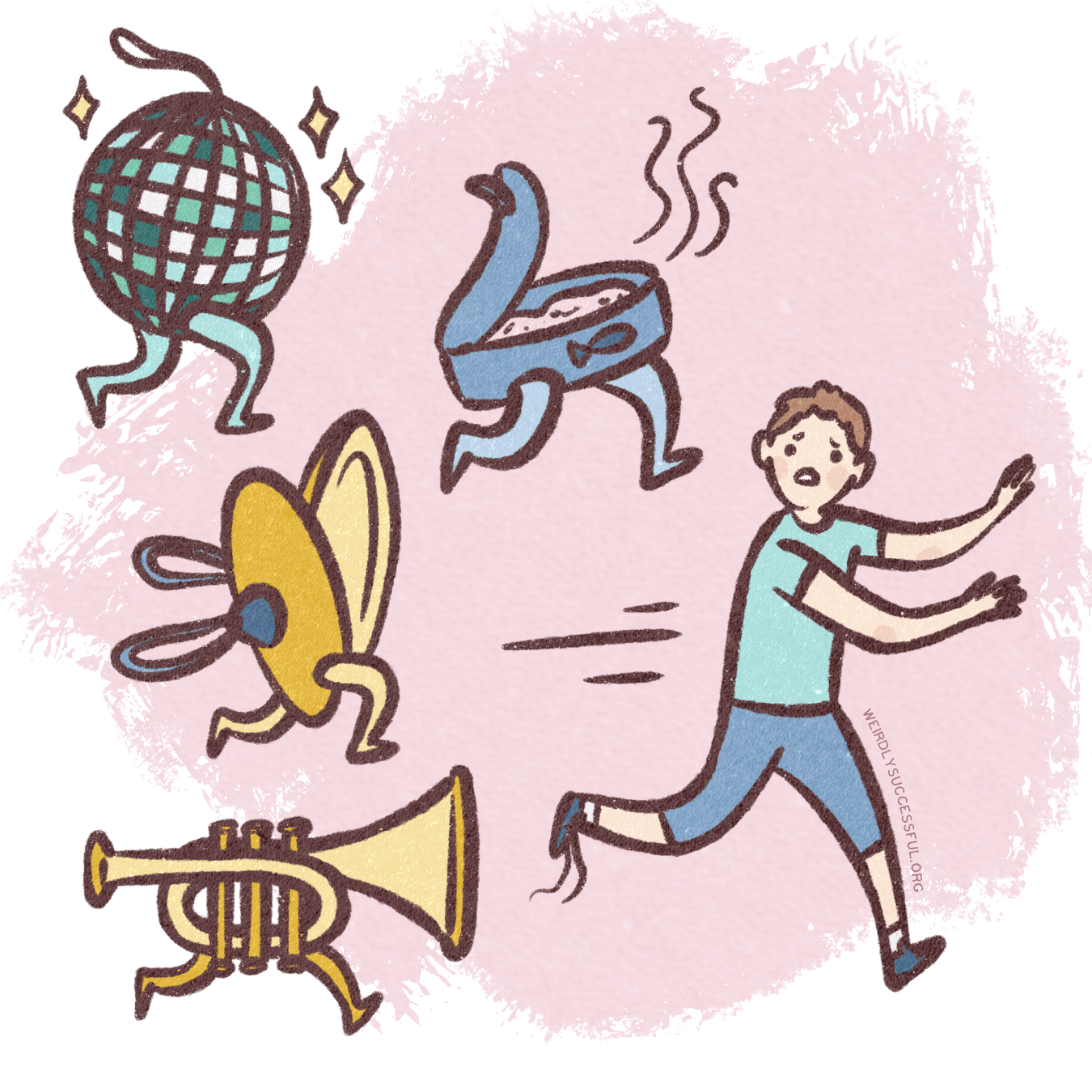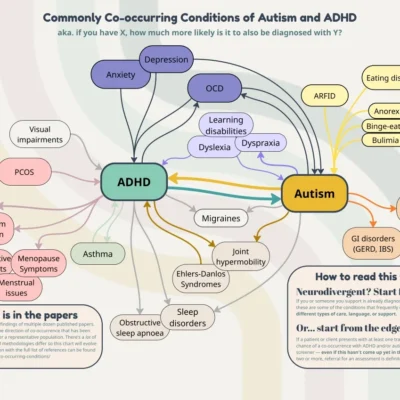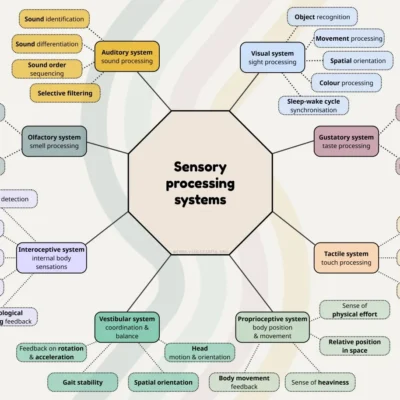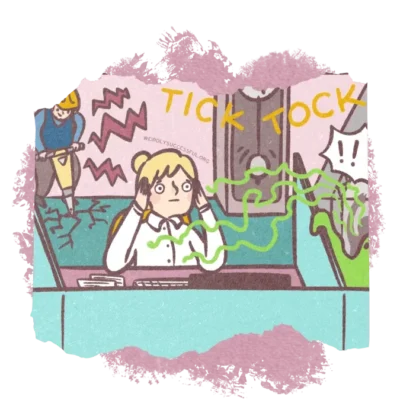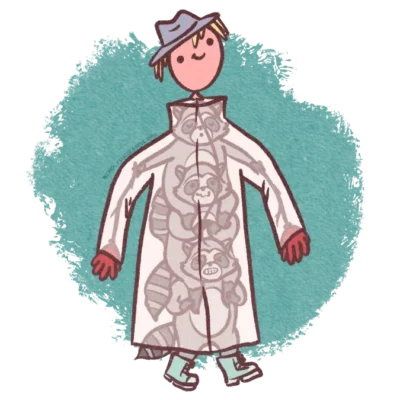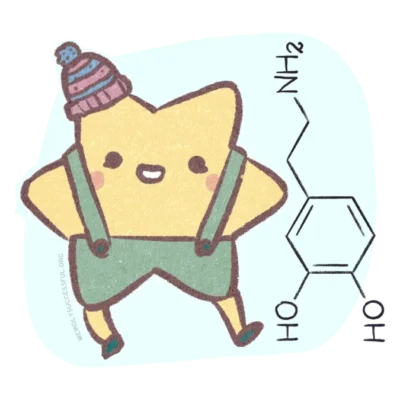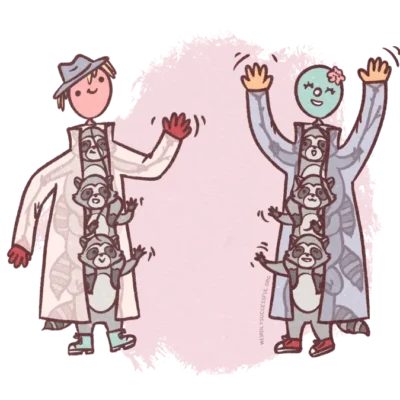Welcome to The Neurodivergent Glossary, Weirdly Successful’s treasure trove of terms in the vast area of neurodivergence, lovingly created to be an approachable mix of the latest research and decades of lived experience. Originally a quick reference guide for terms across our website, it’s now growing into a full-on encyclopaedia of neurodivergence-related definitions, lived examples, analysis and other extras to help clarity, understanding, and making sense of your traits in a neurodivergent context.
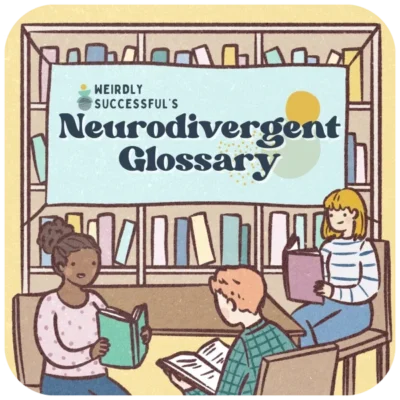
Get a quick overview, or go for a deep dive
The world of neurodivergence can feel like starting a 1980s adventure game: you can’t be sure where to go or what words the system will recognise. (And there’s a faint growling noise behind the waterfall.)
When we started out five years ago, we were overwhelmed by the dozens of new words we suddenly had to navigate, and wondered why there’s no manual that’s easy to navigate and doesn’t need three medical degrees.
Which is why we’ve built this glossary. to help you with what’s what, below you can find all the expressions, terms and special words that can come up during your neurodivergent adventure.
Our glossary term pages each contain the most recent information we have on each term, and we also link to related articles containing that term if you want to learn more.
We’re constantly updating the glossary with more terms and details, so if you frequently browse neurodivergent stuff around the web, keep this tab open or bookmark this page!
Neurodivergent Glossary – Table of Contents
Table of Contents[Hide][Show]
Browse neurodivergent terms by topic
Neurodivergence basics
neurodivergence
Neurodivergent conditions include ADHD, Autism, OCD, Sensory Processing Disorder and specific learning difficulties, like dyslexia, dyscalculia and dysgraphia.
neurodiversity
The word neurodiversity is used to describe a diverse group of individuals with different neurotypes. It includes all humans, though colloquially it is often used for a group of neurodivergent people.
neurotypical
‘Neurotypical’ describes people whose brain functioning follows common patterns, making it easier for them to align with common expectations in areas like processing sensory information, understanding social cues, following conversations and managing everyday tasks.
Most of our current societies are calibrated to neurotypical functioning with narrow margins of error, which can inadvertently disadvantage people whose neurological configurations fall outside the borders of what’s considered ‘typical’.
allistic
The term allistic refers to people who are not autistic. Neurodivergent and neurotypical people can both be allistic if they are not autistic.
neurospicy
An informal and tongue-in-cheek term for neurodivergence, often used in a funny way.
neurodivergent adaptations
Adaptations or coping mechanisms are adjustments you make for yourself or made for you to create a safe and comfortable environment for you to exist in.
Neurodivergent conditions and trait groups
ADHD
ADHD (Attention Deficit Hyperactivity Disorder) is a lifelong, hereditary neurological condition. A person with ADHD can be inattentive, hyperactive and impulsive in their internal mental processes as well as their outward presentation.
ADD (Attention Deficit Disorder) is the previous name of the condition and officially hasn’t been in use since 1987.
autism
Autism is a neurovariety that affects how an autistic person communicates and interacts with their environment.
It is diagnostically characterized by challenges in social interaction, communication, and repetitive or restrictive behaviours. However, many of the traits included in the diagnostic criteria are often simply how an autistic person experiences distress when their needs are not met and they are not supported by adaptations.
Autistic socialising and communication may look different from neurotypical interactions, but the autistic way is not “worse” or “problematic”, it’s just different.
alexithymia
Alexithymia is the inability to assign names to feelings, describe them to others or talk about them. It is considered a separate neuropsychological condition but has significant overlaps with autism.
AuDHD
AuDHD is an unofficial term for co-occurring Autism and ADHD – it is used when someone has both conditions.
autistic speech patterns
Autistic speech patterns refer to unique ways autistic folks communicate or use language, but these patterns can also be present throughout the neurodivergent spectrum.
Autistic speech patterns include
– echolalia (echoing what you or others say),
– palilalia (repeating your own words or phrases),
– scripting (planning what you’ll say),
– verbal stims (using words to stim)
– and vocal stims (using sounds to stim).
demand avoidance
Demand avoidance means you’re opposed to doing something when it’s perceived as a demand, especially coming from an authority figure, even if you want to do the thing. .
PDA stands for Pathological Demand Avoidance or Pervasive Drive for Autonomy.
Autonomy is the core value for people with PDA and any demand that threatens this autonomy triggers a danger-response (fight, flight, freeze).
dyscalculia
Dyscalculia is a learning difficulty where a person has difficulty with numbers and mathematics in general.
dysgraphia
Dysgraphia is a learning difficulty characterized by difficulties in writing, handwriting, and spelling. It is a condition that affects the ability to accurately and efficiently express thoughts or ideas through writing. Individuals with dysgraphia may struggle with letter formation, organizing thoughts coherently on paper, maintaining consistent spacing and alignment, and spelling.
dyslexia
Dyslexia is a learning difficulty. A dyslexic person with has difficulty with literacy skills and retaining information.
dyspraxia
Developmental Coordination Disorder is a neurological condition that affects motor skills and coordination. People with DCD can have trouble with balancing, or tasks that require fine motor skills like tying shoelaces, holding pens or cutlery.
PMDD
PMDD is Premenstrual Disphoric Disorder, and refers to a severe, disabling form of PMS.
Specific Learning Difficulties
Having a learning difficulty means a person has a harder time learning and acquiring skills. Learning difficulties are not related to levels of intelligence, the related conditions are neurological.
Attention and Focus related terms
executive dysfunction
Executive functions are essential, they help us make plans, stay organized, pay attention, and keep our emotions in check. It plays a big role in making decisions and adapting to new situations.
Executive dysfunction can happen when these processes have a difference or impairment that affects everyday life.
hyperfocus
Hyperfocus is a cognitive state characterized by an intense concentration and absorption in a particular task or activity to the point of excluding or neglecting other stimuli or responsibilities.
ADHD paralysis
ADHD paralysis is a form of executive dysfunction.
It refers to the difficulty in initiating, continuing, or completing tasks, even when the person understands the urgency and importance, and also has the ability to do the task. ADHD paralysis can be triggered by various factors, including overwhelm, anxiety, or the perceived complexity of a task.
body doubling
Body doubling means doing a task or errand with someone else or in the presence of someone else so it’s easier to start or follow through.
Their supportive presence helps create a safe, anchoring environment that makes it easier to start and follow through with tasks — without pressure or judgment.
It is one of the strategies for managing focus and creating a flow for work, even if you feel lost and overwhelmed by executive dysfunction.
cognitive load
Cognitive load refers to the total amount of mental effort being used at any given time.
For neurodivergent people, activities that others might find automatic (like maintaining expected facial expressions or processing background noise) can significantly increase cognitive load.
context switching
Context switching refers to the cognitive process of shifting attention between different tasks or mental states. It involves disengaging from one task and engaging in another, requiring the brain to change its focus, rules, and objectives.
This process can be mentally taxing due to the cognitive load involved in stopping one task and starting another, shifting gears to focus on the new task, and getting accustomed to the new situation with all its stimuli. Frequent context switching and jumping from task to task can lead to a decrease in productivity and efficiency.
emotional regulation
Emotional dysregulation refers to difficulty in effectively managing and controlling one’s emotions. It is characterized by intense, unpredictable, or seemingly disproportionate emotional responses that may be challenging to regulate or modulate.
When someone has difficulty regulating their emotions, they are easily overstimulated and they can get upset or overwhelmed easily. On the other hand, they can also have trouble with calming down, relaxing, or decompressing and it takes much effort to regulate their mood.
Emotional dysregulation can also lead to sleep difficulties. Creating helpful routines, focusing on self-compassion, and giving yourself space for unmasking and stimming can help with this process.
hyperactivity
Hyperactive Type is one of the ADHD subtypes. Hyperactivity can present in physical and mental symptoms. Hyperactive traits include fidgeting and other sensory-seeking behaviours, interrupting others when they talk or finishing their sentences for them, impulsive actions and thrill-seeking behaviour (with a reduced sense of danger), having many ideas and blurting them out.
hyperfixation
Hyperfixation is a term often used in the context of neurodivergent individuals, particularly Autistics and ADHDers. It refers to an intense and prolonged focus on a particular subject, topic, or activity, often at the price of excluding everything else.
inattentive
Inattentive is one of the ADHD subtypes, also known as the distracted type. Inattentive traits include daydreaming, forgetfulness (not remembering the question while answering, forgetting things at home, following instructions with multiple sub-tasks), and difficulty focusing on a task that’s not engaging enough.
time blindness
Time blindness is when it’s tough to grasp the passing of time. It usually means you under- or overestimate the time a project will take. It makes it tricky to manage schedules, deadlines, and planning. It can lead to procrastination, forgetfulness, and feeling overwhelmed or rushed.
transitions
Transitioning, in the context of neurodiversity, refers to the process of moving from one state, activity, or place to another. It involves a shift in attention, focus, and cognitive resources.
For neurodivergent individuals, it may require additional time, support, and strategies to manage effectively.
Transitioning can encompass a wide range of changes, from minor daily shifts like moving from one task to another, to major life changes such as transitioning from school to work or from living at home to independent living.
waiting mode
Waiting mode is a psychological state characterized by heightened anticipation or anxiety while awaiting a specific outcome or event.
In the neurodivergent, especially ADHD community it usually means the period before an event that needs focus or attention spent in a sort of paralysing waiting mode, not being able to do little else until the event is over.
working memory
Working memory is one of the executive functions. It is our mental scratchpad, where we temporarily hold and play with info to help with tasks like problem-solving and learning. It’s key for everyday stuff but has limited space, so juggling too much can be tough, especially for people with ADHD, who have an even more …
Sensory terms
Sensory Processing Disorder (SPD)
Sensory Processing Disorder (SPD) is a potential grouping of sensory processing difficulties. As individual sensory processing difficulties are spread across a wide range of diagnoses, SPD is often used as a shorthand to describe significant neurodivergence-related sensory issues that are persistent in a person’s life and limit their participation in everyday life, regardless of what diagnosis they would officially belong to.
hypersensitivity
Hypersensitivity, also known as sensory over-responsivity, is a condition characterized by an extreme sensitivity or heightened response to sensory stimuli from the environment. Individuals with hypersensitivity may have a seemingly exaggerated reaction to various sensory inputs, such as sound, touch, taste, smell, or visual stimuli. These sensitivities can result in discomfort, distress, or even pain, …
ARFID
ARFID stands for Avoidant/Restrictive Food Intake Disorder. It is characterized by highly selective eating habits, often to the point of nutritional deficiency. Unlike anorexia or bulimia, ARFID is not driven by concerns about body image or weight. Instead, it’s typically related to sensory sensitivity, fear of adverse consequences (like choking or vomiting), or a lack of interest in eating.
auditory stimming
Auditory stimming is a natural self-regulatory behavior that involves making sounds with your voice, either through non-word vocalizations (vocal stimming) or speech-based expressions (verbal stimming). This form of stimming helps with emotional regulation, sensory processing, and achieving comfort and focus.
autistic burnout
Autistic burnout refers to a state of physical, mental, and emotional exhaustion experienced by autistic people. It is a result of prolonged exposure to overwhelming sensory, social, and cognitive demands, often in an environment that does not accommodate their needs.
decompressing
Decompressing refers to engaging in activities or behaviours that allow a person to relax, unwind, and alleviate stress or sensory overload.
This term is particularly significant in the neurodivergent community as we often experience heightened sensitivity to environmental stimuli, leading to increased stress and anxiety levels.
Making sure to have time to decompress after especially taxing events is an essential part of self-care.
deep pressure
Deep pressure is a natural sensory need where firm, consistent pressure (like heavy blankets or tight hugs) helps tension melt away from your body. Many people naturally seek this through things like snug clothing or curling up under blankets – it’s your nervous system’s way of finding calm and comfort.
habituation
Habituation is a biological reaction mechanism where if a non-threatening stimuli keeps repeating, the response to it lowers over time. In neurodivergence, the brain’s reduced capacity for habituation means we can’t “tune out” unimportant stimuli, which leads to sensory difficulties and sensory overwhelm.
hyposensitivity
Hyposensitivity, also known as sensory underresponsivity, is a condition characterized by a reduced sensitivity or diminished response to sensory stimuli from the environment.
Individuals with hyposensitivity may have difficulty with detecting or processing sensory inputs, such as sound, touch, taste, smell, or visual stimuli. They may require more intense or prolonged sensory stimulation to register and respond to the sensation.
interoception
Interoception is the ability to notice and identify feelings inside one’s body, like thirst or hunger. It also includes the ability to notice and regulate temperature changes or notice pain.
misophonia
Misophonia is a neurodivergent condition characterized by an intense emotional and physiological response to specific sounds. People with misophonia experience strong negative reactions, such as anger, anxiety, or disgust, when exposed to certain sounds. These sounds can vary from person to person but commonly include chewing, slurping, tapping, or repetitive noises.
restriction
Restriction means being prevented from moving freely or being confined against your will. It can include being held down, trapped, or having your movement controlled by others. This is particularly important for neurodivergent people, who have historically faced harmful practices where restriction was used to stop stimming, force compliance, or ‘manage’ sensory overload.
sensory overwhelm
A feeling of immense distress, a sensory overwhelm / autistic overwhelm is a strong reaction caused by the compounded effects of stress, exhaustion, lack of safety, a sense of danger, unmet needs, too much information, noise, sights or sounds, smells or touch.
sensory-seeking
Sensory-seeking refers to a behavioural pattern or tendency in individuals where they actively seek out and engage in sensory experiences or stimuli. Individuals may have a heightened desire for sensory input and actively seek activities or environments that provide intense or stimulating sensations.
verbal shutdown
Verbal shutdown is a temporary inability to produce speech despite having intact language and thoughts – an involuntary neurological response to overwhelm. It’s when words exist in one’s mind but cannot be physically spoken due to sensory, emotional, or cognitive overload.
Casually and incorrectly it is sometimes also referred to as ‘going non-verbal’, but this term is not preferred by the non-speaking autistic community.
Neuropsychology terms
masking
Masking is a partly unconscious effort to hide or suppress the manifestations of your neurodivergence. It is an exhausting process that many of us do to “fit in” more. Many people start to mask to avoid abuse, discrimination, bullying, harm and ableism.
rumination
Ruminations are thought loops that you seemingly can’t get out of. Examples: thinking about what you should’ve said 5 years ago, feeling anxious if they misunderstood you, or worrying about whether you should’ve behaved differently, did they judge you, whether you were in the wrong, etc. Can be present in both OCD or ADHD.
trauma-informed
A trauma-informed approach is looking out for the needs of the individual with the effect of trauma taken into consideration.
Trauma can have a profound physical, biological, psychological and social effect on a person, and this effect cannot be discounted.
Neurology and biology
dopamine
Dopamine is a neurotransmitter involved in many different functions, including movement, motivation, reward, and pleasure. It is one of the most important neurotransmitters you have to get to know if you want to understand ADHD better.
dopamine pathway
A brain network where dopamine travels, affecting motivation and reward, but also pain and many other functions.
neurotransmitter
Neurotransmitters are chemicals that help brain cells “talk” to each other, controlling thoughts and feelings. Dopamine, serotonin and norepinephrine are all neurotransmitters.
norepinephrine
Also known as noradrenaline – a neurotransmitter involved in alertness, attention, and response to stress.
proprioception
Proprioception refers to the sensory system that provides information about body position, movement, and spatial orientation without visual input (i.e. knowing where our body parts are without having to look at them).
serotonin
Serotonin is a neurotransmitter that helps regulate mood, sleep, and appetite, keeping us balanced.
vestibular system
The vestibular system is a sensory system located in the inner ear that detects head position and movement, working together with vision and proprioception (body position sense) to maintain balance and spatial orientation.
Diagnosis and medication
co-occurring conditions
Co-occurrence means that certain neurodivergent traits and conditions naturally tend to appear together. When you’re neurodivergent in one way, you’re more likely to experience other forms of neurodivergence too – research shows this happens in up to 70% of cases. These patterns extend beyond just neurodevelopmental differences to include physical health and mental health experiences. Understanding co-occurrence is vital because it helps explain how different aspects of neurodivergence connect, leading to better self-understanding and more effective support. While traditional healthcare often treats conditions separately, recognizing these natural connections can transform how you advocate for your needs and access appropriate care.
diagnostic criteria
Diagnostic criteria are prerequisites for a diagnosis: in the case of neurodivergence, they are the presentations and traits an assessor is looking for when diagnosing a person with a neurodivergent condition.
high-masking
High-masking refers to a person who is able to mask so efficiently that they ‘pass’ as neurotypical. High-masking is often one of the reasons women go undiagnosed – unfortunately, many assessors completely ignore masking and dismiss the experience of the individual.
SSRIs
SSRIs are a type of antidepressant, the name stands for Selective serotonin reuptake inhibitor. They are often successfully used to treat OCD, PMDD, anxiety, PTSD and depression.
Society and social attitudes
neuroaffirming
Neuroaffirming or neuro-affirmative refers to practices, approaches, or environments that recognize and affirm the neurodiversity of society and the neurodivergence of individuals.
double empathy
The double empathy problem is a concept in neurodiversity studies that suggests a mutual misunderstanding between neurodivergent and neurotypical individuals.
It states that the perceived social communication deficits in neurodivergent people may not be due to an inherent impairment, but rather a reciprocal lack of understanding or empathy between different neurotypes.
This theory challenges the traditional deficit model of neurodivergence, emphasizing that empathy is a two-way process, and both parties bear responsibility for successful communication.
unmasking
Unmasking is when you slowly learn to allow your neurodivergence to present itself and you don’t try to hide yourself. However, to unmask is a privilege, as you need a safe space to do it.
ableism
Ableism is discrimination and social prejudice against people with physical or mental disabilities. In an ableist society, it’s assumed that the “normal” way to live is as a non-disabled person and that every disabled person needs to or wants to “get rid of” their condition.
curb-cut effect
The curb-cut effect refers to the phenomenon that policies initially created to serve a marginalized group end up serving a much more significant portion of society, benefiting even more people than it was originally designed for.
internalised ableism
Internalised ableism is a psychological construct that refers to the internalisation of negative beliefs, stereotypes, and prejudices about disabilities that are prevalent in society.
It involves self-stigmatization and the development of a negative self-concept based on one’s disability and onboarding negative beliefs said to us by parental figures, teachers, grown-ups and society in general.
penguin pebbling
Penguin pebbling is a term derived from the behaviour of Adélie penguins who meticulously collect and arrange pebbles to build their nests.
In a neurodivergent context, the expression is used to describe a common neurodivergent behaviour of people collecting and giving loved items to others – “this made me think of you, I think you’ll like this, I thought this was pretty and I want you to have it”.
spiritual bypassing
Spiritual bypassing is a dismissive behaviour, meaning the use of spiritual explanations to dismiss, diminish or avoid dealing with complicated emotions, uncomfortable experiences or facing the complex and often harsh realities of life. It’s part magical thinking and part toxic positivity.
Alphabetical Search
If you only remember that the word you’re looking for starts with something like “neuro…” or “echo”, try our A-Z alphabetical catalogue below. And if you’re not exactly sure what you’re looking for, or if you want a single page with all of the short definitions on it for printing, our new one-page A to Z list of all neurodivergent glossary items is just for you.
- ableism
- able-bodism
- neurodivergent adaptations
- coping strategies
- coping mechanisms
- coping skills
- adaptations
- adjustments
- accommodations
- adaptive mechanism
- ADHD
- ADHD paralysis
- task initiation
- ADHD tax
- alexithymia
- emotional blindness
- allistic
- ARFID
- AuDHD
- auditory stimming
- vocal stimming
- verbal stimming
- autism
- Autism Spectrum Condition (ASC)
- Autism Spectrum Disorder (ASD)
- autistic burnout
- autistic speech patterns
- body doubling
- co-occurring conditions
- comorbidity
- co-occurrence
- cognitive load
- context switching
- task switching
- set shifting
- curb-cut effect
- decision fatigue
- decompressing
- deep pressure
- demand avoidance
- PDA
- diagnostic criteria
- dopamine
- dopamine pathway
- double empathy
- dyscalculia
- dysgraphia
- dyslexia
- dyspraxia
- Developmental Coordination Disorder
- echolalia
- emotional regulation
- executive dysfunction
- executive function deficit
- executive function disorder (EFD)
- flat affect
- resting b*tch face
- habituation
- high-masking
- hyperactivity
- hyperfixation
- hyperfocus
- hypersensitivity
- hyposensitivity
- inattentive
- inertia
- info dumping
- monologuing
- internalised ableism
- interoception
- masking
- misophonia
- misophonic disorder
- neuroaffirming
- neurodivergence
- neurodiversity
- neurospicy
- neurotransmitter
- neurotypical
- neuronormative
- norepinephrine
- object constancy
- palilalia
- penguin pebbling
- PMDD
- proprioception
- restriction
- rumination
- scripting
- rehearsing conversations
- sensory avoiding
- sensory overwhelm
- autistic meltdown
- shutdown
- sensory overload
- Sensory processing difficulties
- Sensory Processing Disorder
- SPD
- sensory-seeking
- sensory craving
- serotonin
- Specific Learning Difficulties
- spiritual bypassing
- SSRIs
- stimming
- self-stimulating
- stereotyped or repetitive motor movements
- stimulus
- time blindness
- titration
- transitions
- trauma-informed
- unmasking
- verbal shutdown
- intermittent speech
- unreliable speech
- lost speech
- vestibular system
- waiting mode
- working memory
May the neurodivergent glossary be with you, always (on the website, anyway)
Here’s the best news: you don’t have to remember any of this. While you can always return to the glossary to dive in and explore, you can also just go off and browse our blog posts. We’ve set up the Weirdly Successful website so the glossary is always with you when you need it:
- All terms for which we have already written a definition will be underlined with a dotted line.
- If you hover over underlined terms on a desktop browser, a handy little box with a short explanation will appear.
- You can then keep reading or click the term to go to its glossary page.
- On phones, tapping on dotted-line terms will open the glossary page in a new tab.



